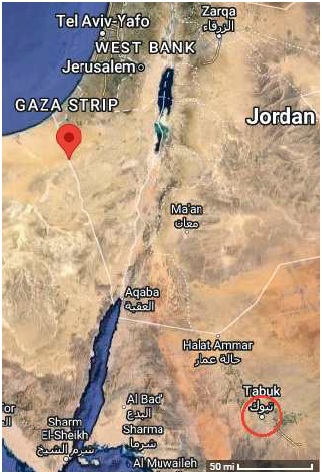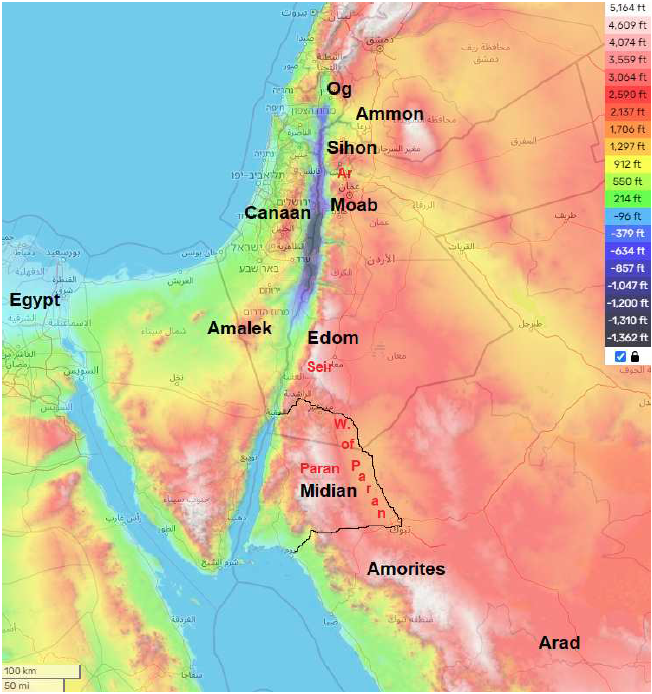
 | |
| Volume 14, Number 15 | September 17, 2024 |
The wilderness of Paran appears in several places in the biblical historical narrative of the Exodus. Unfortunately, its first mention as it appears in the NASB may cause some confusion regarding its location.
Now it came about in the second year, in the second month, on the twentieth of the month, that the cloud was lifted from over the tabernacle of the testimony; and the sons of Israel set out on their journeys from the wilderness of Sinai. Then the cloud settled down in the wilderness of Paran. (Numbers 10:11–12)This is easily misunderstood to be saying that the pillar of cloud lifted from the wilderness of Sinai encampment and moved directly to the wilderness of Paran and settled there. This interpretation makes the wilderness of Paran to be the Israelites' next stop along the way to Canaan, which would imply that the wilderness of Paran must be located within roughly a day's journey (30 miles) of the wilderness of Sinai.
The subsequent narrative clarifies that this is not what is intended by these verses. The actual sequence of events is: 1) the cloud lifted from the Sinai encampment, where the Israelites had been camped in front of Mount Sinai for nearly a year[1] and 2) hopped in fairly rapid succession from encampment to encampment, 19 encampments in all, before 3) arriving at the wilderness of Paran, where it settled down to stay for nearly 38 years.[2]
The Numbers 10:11–12 passage quoted previously encompasses all of this. It summarizes, showing where the narrative is going. It is not intended to provide information about the location of the wilderness of Paran. The NIV makes this meaning explicit.
On the twentieth day of the second month of the second year, the cloud lifted from above the tabernacle of the covenant law. Then the Israelites set out from the Desert of Sinai and traveled from place to place until the cloud came to rest in the Desert of Paran. (Numbers 10:11–12, NIV)
The key to solving the mystery of the location of the wilderness of Paran is knowledge of the correct location of Kadesh-barnea, for the biblical historical narrative is explicit that Kadesh-barnea was located in the wilderness of Paran.
When they returned from spying out the land, at the end of forty days, they proceeded to come to Moses and Aaron and to all the congregation of the sons of Israel in the wilderness of Paran, at Kadesh… (Numbers 13:25–26a)
The true location of Kadesh-barnea, at modern Tabuk, Saudi Arabia (Figure 1), has been known for over a year.[3] This location is far from the generally accepted one in the northern Sinai desert.[4] But the Tabuk location for Kadesh-barnea has already successfully played a pivotal role in solving the mysteries of: 1) the location of Mount Hor,[5] 2) the location of Ezion-geber,[6] and 3) the location of the ascent of Akrabbim,[7] substantiating it. This same location now solves the mystery of the location of the wilderness of Paran, further corroborating it.
 |
Figure 2 shows my proposed solution, drawn on the map of the major political entities of the Exodus published last issue. This solution is derived as follows.
 |
First, we know that Tabuk/Kadesh-barnea is in the wilderness of Paran. This anchors the wilderness to the southeast corner of Midian.
Next, we must determine how far the wilderness of Paran extends in all directions.
In modern times, it is customary to think in topographical terms. This would make the wilderness of Paran to be the entire orange plain of which Tabuk/Kadesh-barnea is a part. But we have seen previously that wildernesses of the Exodus tended to be named by landmarks such as cities or mountains to which they were adjacent.[8] Thinking in this ancient way, it seems more likely that the wilderness of Paran was just that portion of the orange plain which was associated with the Paran landmark. This leads to the question, "What was the Paran landmark?"
I suggest that the Paran landmark was Mount Paran, mentioned by Moses while blessing the nation of Israel just prior to his death (Deuteronomy 33:2a).
And he said,I suggest that Mount Paran would not be a singular mountain but rather would refer to the conglomeration of mountains making up the mountain range in Midian. This is analogous to Seir, which is the mountain range in Edom. It is variously referred to simply as "Seir" (as in the verse quoted above) or as "Mount Seir" (Deuteronomy 1:2, for example). The same custom would be expected to apply to "Paran" and "Mount Paran." Farther north, in Moab, the mountain range is called Ar. The northern extremity of Ar was taken from Moab by Sihon (Numbers 21:26–28). Thus, there seems to be both fixed topographical names (Ar, Seir, and Paran) and corresponding but potentially changing political/ethnic names of people groups inhabiting these mountain ranges (Moab, Edom, Midian) in the biblical historical Exodus narrative. This gives rise to the possibility of referring to a wilderness by the political/ethnic name related to its topographical landmark. We find a "wilderness of Moab" (Deuteronomy 2:8), for example. This would have had the advantage of being more specific in this instance than "wilderness of Ar" since it would have excluded any portion of the wilderness of Ar falling within the territorial boundaries of Sihon.
"The Lord came from Sinai,
And dawned on them from Seir;
He shone forth from Mount Paran,
…
This way of thinking then limits the wilderness of Paran to just that portion of the orange plain which lies at the eastern feet of the Paran mountain range within the boundaries of Midian. Since Edom lay on the other side of this boundary, the orange plain there would likely have been called the wilderness of Edom, and its northeastern part especially might also have been called the wilderness of Seir. ◇
The Biblical Chronologist is written and edited by Gerald E. Aardsma, a Ph.D. scientist (nuclear physics) with special background in radioisotopic dating methods such as radiocarbon. The Biblical Chronologist has a fourfold purpose:
The Biblical Chronologist (ISSN 1081-762X) is published by: Aardsma Research & Publishing Copyright © 2024 by Aardsma Research & Publishing. All scripture quotations, unless otherwise noted, are taken from the (NASB®) New American Standard Bible®, Copyright© 1960, 1971, 1977, 1995 by The Lockman Foundation. Used by permission. All rights reserved. www.Lockman.org } |
^ The Israelites came to the wilderness of Sinai in the third month of their first year after their Exodus from Egypt (Numbers 19:1) and left near the end of the second month of the second year after leaving Egypt (Numbers 10:11).
^ The Israelites journeyed from Kadesh to Mount Hor, one day's travel, on their way to the plains of Moab to launch the Eviction/Conquest of Canaan. Aaron died on Mount Hor in the fortieth year, fifth month, first day (Numbers 33:38). Thus, the interval of time between leaving Sinai and leaving Kadesh was 38 years, 3 (lunar) months, 20 days. Meanwhile, Deuteronomy 2:14 informs us that 38 years transpired between the Israelites entering Kadesh-barnea and their crossing of the brook Zered on their way to the plains of Moab. So their stay at Kadesh-barnea, in the wilderness of Paran, must have lasted nearly 38 years.
^ Gerald E. Aardsma, "The Route of the Exodus, Part V: The Location of Kadesh-barnea," The Biblical Chronologist 13.4 (March 28, 2023): 1–6. www.BiblicalChronologist.org.
^ Isaac Gilead, "Kadesh-barnea: The Prehistoric Sites," The New Encyclopedia of Archaeological Excavations in the Holy Land, vol. 3 (New York: Simon & Schuster, 1993), 841–843. Rudolf Cohen, "Kadesh-barnea: The Israelite Fortress," The New Encyclopedia of Archaeological Excavations in the Holy Land, vol. 3 (New York: Simon & Schuster, 1993), 843–847.
^ Gerald E. Aardsma, "The Route of the Exodus, Part VII: The Location of Mount Hor," The Biblical Chronologist 13.7 (September 8, 2023): 1–10. www.BiblicalChronologist.org.
^ Gerald E. Aardsma, "The Route of the Exodus, Part VIII: The Location of Ezion-geber (and Elath)," The Biblical Chronologist 14.1 (January 01, 2024): 1–6. www.BiblicalChronologist.org.
^ Gerald E. Aardsma, "The Location of the Ascent of Akrabbim," The Biblical Chronologist 14.7 (April 30, 2024): 1–5. www.BiblicalChronologist.org.
^ Gerald E. Aardsma, "The Locations of the Wilderness of Shur, the City of Shur, and the Wilderness of Etham," The Biblical Chronologist 14.2 (January 30, 2024): 1–6. www.BiblicalChronologist.org.